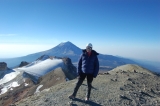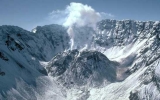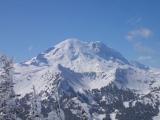|
Bert Schippers |
|
| My Mt. Rainier Summit Climb
I started making climbs of Tiger Mountain (just off I-90 in Issaquah, WA) and Mt. Si in North Bend, WA.
I also worked out at Golden Gardens park in Seattle. From the edge of Puget Sound, this is a 300-foot elevation gain up the bluff on trails & long steep flights of stairs, enabling a great workout – going up and down again and again. I gradually worked up to carrying a 45-lb backpack on all of my workouts – 2 stair climbing sessions and one mountain every week. Every climb was a lot of work. But eventually I didn’t really notice the heavy pack – it seemed just to be part of me. Plenty of others were doing the same as I, up and down the bluff with heavy backpacks – in conversation I found some also were training for Rainier. Two weeks before my scheduled summit climb, I had the opportunity to go on a climb to Camp Muir at the 10,000 foot level with several business associates. Muir is the primary base camp for climbs to the summit. This was a great time to test my conditioning. We left Paradise at about 10:00 a.m., and climbed about 5.5 hours to reach Muir. It was a long, tough climb, and the air
is a lot thinner at this altitude. The views are incredible and it was a
beautiful sunny day. I felt the effects of the altitude – slight Once we all ate and got packed up, we started back down the mountain to Paradise.
Two weeks later, it is time. The summit climb program is a 3-day affair. The first day is a training day, where you learn the basics in mountaineering and they also have the opportunity to assess your physical condition. If you don’t pass, you don’t go on the summit climb. Everyone arrives in
Ashford, the location of RMI (Rainier Mountaineering, Inc.), picks up
rental gear and gets ready. After a 45-minute drive up to Paradise, we
hike uphill at a quick pace for about an hour to the training area where
we learn the basics: rest-stepping, July 6th, day
1 of the climb arrives. We start again at Paradise – first a gear check,
then we’re on our way to Camp Muir. We are
Here we have a break of
2-3 hours before lying down to rest. We get our gear ready, learn how to
put on a harness, avalanche
For the next 1.5 hours, we dress in the gear recommended by the guides based on the current weather, eat and drink (hot water provided again), and finally assemble with our assigned team/guide to get roped up for the climb. RMI has toilet-paper supplied outhouses and it is encouraged that you use them, much easier than "blue-bagging it" on the mountain above. The "blue-bag" system is basically 2 bags which are for picking up, sealing and double-bagging your business to be carried off the mountain. This helps keep the mountain pristine and safe for all. At approximately 2:30 a.m. we start up the mountain. It is dark and clear out. Looking at the sky I can see the Milky Way and thousands of stars. But, it is hard to tell what is going on near the top of the mountain. In the dark, using our
headlamps, we march up the mountain. It is hard to do much but look at the
ground in front of you, making sure you know where your next step will be.
We climb for about an hour, across the Cowlitz Glacier, then up a rocky
area and finally onto the Ingraham Flats to our first break. After putting
on our down parkas to preserve body heat generated by the exertion of the
climb, we drink and eat a snack. The next leg of the climb is the longest,
about 1.5 hours across the Ingraham Glacier and up Disappointment Cleaver.
Hear you have to keep moving since along this route you are exposed to
rock and ice fall. There are some steep edges, so you just keep looking
where you are stepping… Finally, 2nd
break. Rest, eat, drink. And enjoy the view – sunrise is in progress.
The colors and views are incredible. Unfortunately, a look up the mountain
top affords only a view of a cloud, seeming to increase in size. We are
now at about 12,300 ft. We start up again. Group A has reached the
summit but can see nothing in the whiteout conditions and has to
"touch & go" – step up, step on, step down and get out of
there for safety’s sake. Our group is given the bad news: we won’t go
further. Safety is the guides’ primary concern, and the climb isn’t
over until we get back to Paradise. I am disappointed to say the least - I
fully intended on reaching the summit.
Once again the mountain
has created its own weather at the summit. A couple more hours and we are
back at Camp Muir to rest and repack our gear for the climb back There is not much of a feeling of having accomplished anything, and most of us keep to ourselves. Another climber asks me if I’ll attempt it again, and I say probably not. It is an exhausting ordeal, I’m tired and sunburned again in a few spots (the guides who climbed Mt. McKinley said they had sunburned the inside of their mouths & nostrils!) and find it difficult to imagine doing this all again. In the next few days, the weather is clear and we see Mt. Rainier clearly all the way from Seattle. I feel betrayed, why wasn’t the weather good on my climb, it was near perfect weather the few days before. Well, the mountain has it’s own weather system, and follows no rules. Less than a week after my climb, I decide to go for the summit again. After all, that was my original goal. Although the guide service is booked full for months in advance, I get onto their on-call list, since sometimes people cancel, etc. I also want to be sure that the weather forecast is good before I sign on. Late in the day on Friday the 19th, the weather looks extremely promising, no clouds in sight, I call in to see if there are any openings. There has just had been a "no pass" on the training that day, leaving a slot open for the next day’s climb! I am on – now I have to prepare the remainder of the evening and be ready to get up early for the 2 hour drive to base camp in Ashford. Having climbed to 13,000
feet 2 weeks earlier, I have no doubt that I am in good enough shape to
make it to the top. Meeting with the other climbers, several mention
"2nd
time’s a charm", meaning that this time I’ll make it to the top
– and of course indicating that they’ll make it on their first go! I
feel a bit like a veteran, since I know everything that the guides will be
telling us, etc. It makes it easier for me to plan my packing, food, and
things of that nature. This time we are group A
– we start with a group of 13 climbers and 3 guides, leaving Paradise at
9:50. The hike to Muir goes quickly, and we arrive at about 3:00. But only
11 of the group have made it, one climber became too exhausted, and
another was having trouble with his shin where he’d had an injury a
month before. Arriving at 3:00, we have plenty of time to rest and prepare for the climb ahead of us. At about 5:00, hot water is provided and we eat dinner. Mine consists of an instant soup, with leftover chicken added from yesterday’s dinner at home. It is a good meal. Then, to bed, at 6:00 p.m.. Even though I am tired, it is hard to sleep. We know that we’d be awakened somewhere between 11:00 p.m. and 3:00 a.m., but I know it will be early. Finally, at 11:00 p.m., it is time to get up! The earlier hour is due to the warm temperatures – so we can summit before the snow softens too much in the sun, increasing the chances of snow and ice fall. I feel like I’ve slept about 2-3 hours if I am lucky. For the next hour or so,
we eat, get our gear on, and prepare to climb. It is very good weather
out, not cold at all – relatively speaking – I think the temperature
is in the low 40s (F). My group’s guide is Kristen, a small but strong
woman. She only weighs about 105 At 12:21, we set off. I am excited to finally get going! We climb for an hour across the Cowlitz Glacier and Cathedral Rocks until we reach the Ingraham Flats. The snow has melted a lot in two weeks and there is a lot more loose bare rock in this section of the climb. I find climbing on the rocks with crampons on my boots to be one of the more difficult aspects of the climb. The crampons actually give you a better grip of the rocks, but at the same time there is an awkward feel to it – takes a bit of getting used to. It is still dark out, but with the moon nearing its full stage it is easy to see (in addition to our headlamps). On again to the longest
stretch of the climb up Disappointment Cleaver. During almost the entire
climb we breathe using the pressure breathing method taught to us during
the climbing school. Without this, I’m sure many climbers would get sick
and/or not make it. In The rest break above the
Cleaver is welcome. I’m actually not that hungry, so I only have a bit
of water. The guides tell you to eat and drink even if you aren’t
hungry, but I find that difficult to do. Onward once again – each break
is about 15 minutes, though they seem to only be 2-3… Finally, along with a beautiful sunrise, we reach High Break! This is at 13,400 ft. I am excited, as I know for sure we are going to make it. The rest of the climbers are doing ok (nobody’s complaining). I try to snap photos at every break, and the colors of the sunrise and the view in the clear weather is stunning.
This is about 14,200 ft.
The lead guide Brent indicates that he’s heading across the crater to
Columbia Crest, the highest point on the mountain at 14,410 feet. We leave
our packs and unhook from the rope (there is no danger of falling here),
and head to the very top! I’m now thankful that I didn’t make it to
the summit on the previous climb, since with the weather there was no
chance of a view… On the far side of the
crater there is a metal box that contains pens and a log, where you get to
sign your name for having made it to the summit! Periodically this
register gets picked up and filed in the park’s archives and eventually
the national archives. Then, a few more steps and we are at THE TOP, with
a full 360 degree view!
The view stretching away
in every direction to Mt. Hood, Mt. Adams, Mt. St. Helens, the Cascades
& Puget Sound in the mist is incredible, and it is hard to believe I
am at the top of
The guide tells us a
story about all the expensive tents and gear that the wind has picked up
and blown irretrievably into the crevasses while the owners were above on
their summit attempts! We reach Muir at about 11:00, rest and We get on the bus for the ride back down to base camp at Ashford. At Ashford, the guides hand out Summit Certificates, a nice memento for the achievement made. For anyone interested in making this climb, I’d highly recommend Rainier Mountaineering, Inc. for their guide services. They train you and take care of much of the details, and have all of the gear needed available for rental. You just need to be sure you are in shape. This climb is definitely the most challenging physical activity I’ve ever taken on. Thank you for taking your time to read this.
Bert Schippers If you have any questions or comments, feel free to email me at bert@schippers.com
|
My previous Adventures
|
|
©2008 Bert Schippers |
|









 a
climbing method where you rest a brief moment on the leg which is extended
straight down, thus allowing the leg muscles to rest as your bone
structure supports the body; pressure breathing, this is a forced
exhalation
a
climbing method where you rest a brief moment on the leg which is extended
straight down, thus allowing the leg muscles to rest as your bone
structure supports the body; pressure breathing, this is a forced
exhalation  of
air, so that when you inhale you breathe in more oxygen; ice-axe use and
self-arrest procedures, how to stop yourself from falling using your
ice-axe; how to put on and use
crampons (spikes attached to your boots for gripping in the snow and ice);
team rope procedures and a variety of topics such as what to wear and what
to eat, etc. We drill all of the procedures until about 3:00, then hike
back down to Paradise for the bus ride to Ashford. A lot to learn in a
short time. At Ashford I learn that I passed.
of
air, so that when you inhale you breathe in more oxygen; ice-axe use and
self-arrest procedures, how to stop yourself from falling using your
ice-axe; how to put on and use
crampons (spikes attached to your boots for gripping in the snow and ice);
team rope procedures and a variety of topics such as what to wear and what
to eat, etc. We drill all of the procedures until about 3:00, then hike
back down to Paradise for the bus ride to Ashford. A lot to learn in a
short time. At Ashford I learn that I passed.
































